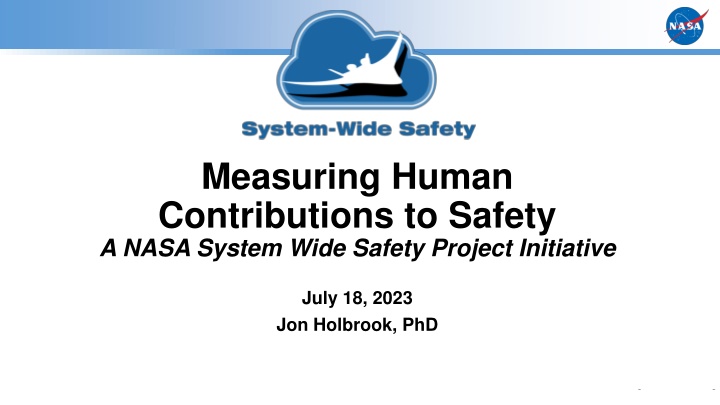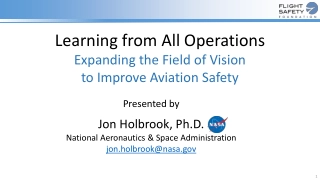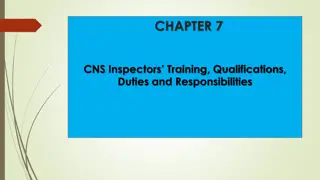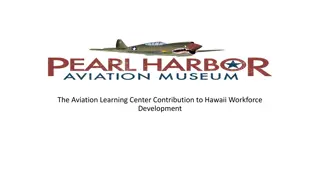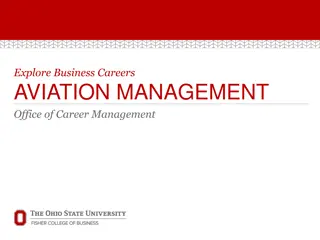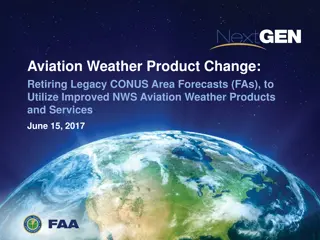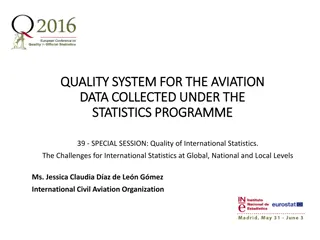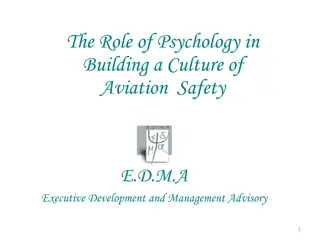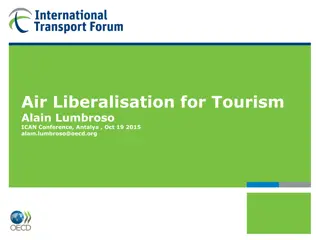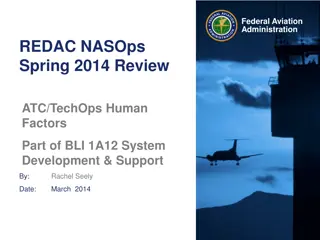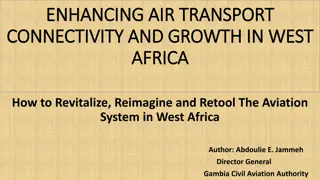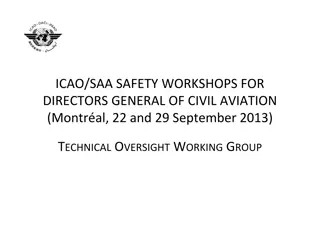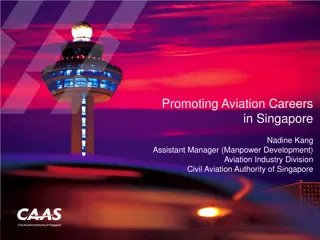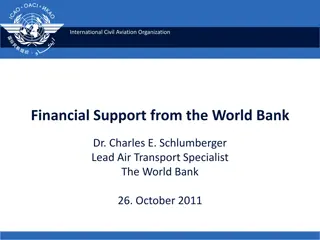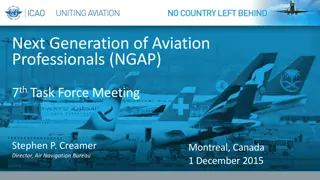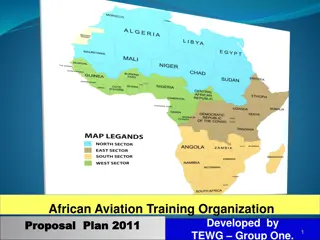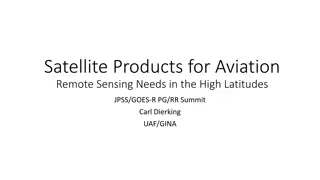Enhancing Aviation Safety Through Human Contributions
The NASA System Wide Safety Project Initiative focuses on transforming aviation through new technologies and policies to enhance safety. The Human Contributions to Safety (HC2S) Initiative highlights the vital role of people in maintaining aviation safety. Despite human error being a factor in many accidents, pilots are shown to intervene effectively to prevent disasters, showcasing their important role in ensuring flight safety.
Download Presentation

Please find below an Image/Link to download the presentation.
The content on the website is provided AS IS for your information and personal use only. It may not be sold, licensed, or shared on other websites without obtaining consent from the author.If you encounter any issues during the download, it is possible that the publisher has removed the file from their server.
You are allowed to download the files provided on this website for personal or commercial use, subject to the condition that they are used lawfully. All files are the property of their respective owners.
The content on the website is provided AS IS for your information and personal use only. It may not be sold, licensed, or shared on other websites without obtaining consent from the author.
E N D
Presentation Transcript
Measuring Human Contributions to Safety A NASA System Wide Safety Project Initiative July 18, 2023 Jon Holbrook, PhD
Human Contributions to Safety (HC2S) Initiative System Wide Safety (SWS) Project focus: Transformational changes in aviation to make flight more efficient and accessible will require new technologies, policies, and procedures. Enabling these changes to be done safely at every step is the goal of the SWS project. Human Contributions to Safety (HC2S) Initiative focus: People represent the primary source of safety in aviation, through their capability to anticipate, monitor for, respond to, and learn from expected and unexpected change. Understanding and measuring this capability so that it can be integrated into the design of technologies, policies, and procedures is the goal of the HC2S initiative.
How to Change the Narrative that people are the safety problem PROBLEM DESCRIPTION Human error is implicated in 80% of aviation accidents, so To fast forward to the safest possible operational state network operators will be interested in the path that realizes full machine autonomy as quickly as possible. (Uber, 2016) Recent analysis based on accident and LOSA data estimates that pilots intervene to keep flights safe from aircraft malfunctions ~157,000 times for every time that human error contributes to an accident.
Pilots Produce Safety Far More Often than They Reduce It Human error has been implicated in up to 80% of accidents in civil and military aviation1
Pilots Produce Safety Far More Often than They Reduce It Human error has been implicated in up to 80% of accidents in civil and military aviation1 Outcome Not Accident Accident Human Intervention ? 20% ? No Attributed to 80% ? ? Yes ? ? ?
Pilots Produce Safety Far More Often than They Reduce It Human error has been implicated in up to 80% of accidents in civil and military aviation1 Outcome Not Accident Accident Human Intervention Pilots intervene to manage aircraft malfunctions on 20% of normal flights2 80% 20% ? No Attributed to 20% 80% ? Yes ? ? ?
Pilots Produce Safety Far More Often than They Reduce It Human error has been implicated in up to 80% of accidents in civil and military aviation1 Outcome Not Accident Accident Human Intervention Pilots intervene to manage aircraft malfunctions on 20% of normal flights2 80% 20% ? No Attributed to 20% 80% ? Yes World-wide jet data from 2007-20163 244 million departures 388 accidents 388 244,000,000 243,999,612
Pilots Produce Safety Far More Often than They Reduce It Human error has been implicated in up to 80% of accidents in civil and military aviation1 Outcome Not Accident Accident Human Intervention Pilots intervene to manage aircraft malfunctions on 20% of normal flights2 195,199,690 78 195,199,768 No Attributed to 48,799,922 310 48,800,232 Yes World-wide jet data from 2007-20163 244 million departures 388 accidents 244,000,000 388 243,999,612
Pilots Produce Safety Far More Often than They Reduce It Human error has been implicated in up to 80% of accidents in civil and military aviation1 Outcome Frequently Studied Not Accident Accident Human Intervention Pilots intervene to manage aircraft malfunctions on 20% of normal flights2 195,199,690 78 195,199,768 No Attributed to 48,799,922 310 48,800,232 Yes World-wide jet data from 2007-20163 244 million departures 388 accidents 244,000,000 388 243,999,612 Rarely Recognized Learn more: Holbrook, J. (2021). Exploring methods to collect and analyze data on human contributions to aviation safety. In Proceedings of the 2021 International Symposium on Aviation Psychology. https://aviation-psychology.org/wp- content/uploads/2021/05/ISAP_2021_Proceedings_FINAL.pdf (1) Weigmann & Shappell, 2003; (2) PARC/CAST, 2013; (3) Boeing, 2017
How to Change the Narrative that people are the safety problem IMPLICATIONS Designs intended to protect the system from error-prone humans can design-out the capability for the human to effectively intervene / adapt, which is a far more common behavior Designs intended to replace humans often fail to acknowledge or understand the capabilities that humans routinely contribute to safety, and therefore fail (or don t have the data/knowledge) to design that into the system Designs that leverage a safety pilot who will only intervene to save the day in rare failure events fail to consider how our cognitive systems work and how they evolved to work. Such designs are setting up the safety pilot to fail.
How to Change the Narrative that people are the safety problem PROPOSED SOLUTION In today s aerospace industry, data talks When the only data that are available are about human failure, then data-driven designs only consider that humans fail To change the narrative, we need new data and new ways to examine data Specifically, data on how (and the processes by which) humans contribute to safety IMPACTS Safer system designs Increased organizational awareness Improved operational learning/training System safety that is robust to future changes
Human Contributions to Safety (HC2S) Initiative Expand the range of safety-relevant events to include not just rare safety failures but frequent safety successes Create a data testbed to enable exploration of methods and metrics for pilot contributions to safety and mission success Develop methods and metrics for learning from what happens Structured observation Self reports System data Learn from simulations and operations
HC2S Testbed Operational Concept How do pilots respond to expected and unexpected disturbances during arrivals? Using NASA Langley s Integrated Flight Deck (IFD) simulator, 12 crews of Boeing 737-rated pilots from a US air carrier performed multiple arrivals into Charlotte Douglas International Airport (KCLT) Created an environment realistic enough to leverage expertise and flexible enough to enable a range of possible behaviors Included a range of challenging but manageable pressures Our interest was in the processes by which crews adapted to manage those pressures (not just outcomes) Image Credit: NASA Image Credit: NASA
What is in the HC2S Data Testbed? Observer-based data Over the shoulder video recordings to enable post-hoc expert observation Self-report data Demographics survey System resilience potential Subjective workload Subjective situation awareness System-based data (Simulated) flight data Psychophysiological measures Eye/gaze tracking Electroencephalography (EEG) Electrocardiography (ECG) Heart rate variability Resilient performance self-assessment Resilient performance surveys Event narratives Cued retrospective think-aloud Galvanic skin response Skin temperature Accelerometry
Video Data for Structured Observation Understand how different knowledge frameworks impact insights Identify methods/strategies for refining what behaviors to observe (i.e., which behaviors provide the most impactful insights, etc.) Can observers identify what crews (reported they) were thinking? Provide a resource for training observers Image Credit: NASA
Event Report Narrative Data From the Data Testbed From Operational Data Approach #1: Leverage the vastness of report narratives (over 1.8 million in the ASRS database) to explore trends and patterns; detect anomalies and workarounds; etc. Approach #2: Leverage the richness of a small set of narratives to enable/enrich the ability of individuals to learn from others experiences. Image Credit: NASA
Cued Retrospective Think-Aloud Data FO/PF (blue) | CA/PM (red)
Simulated Flight Data Roll Angle Latitude Longitude Altitude Corrected AOA Pitch Angle APPR SPD TARGET COMPUTED AIRSPD N1 ACTUAL (LOW ROTOR SPD) N2 ACTUAL (HGH ROTOR SPD) PFD SELECTD SPEED DRIFT ANGLE YAW WIND SPD A/P HEADING MODE A/P NAV MODE A/P RUNWAY MODE A/P LOC MODE A/P TRACK A/P APROACH A/P ALT MODE A/P VERT SPD MODE A/P GS MODE A/P CLIMB A/P DECEND AP1 ENGAGD AP2 ENGAGD FD1 ENGAGD FD2 ENGAGD ATS ENGAGD ATS ACTIVE GEAR LEVER POS FLAPS SPD BRAKES
Psychophysiological Data B-ALERT X10 Electroencephalography (EEG) Electrocardiography (ECG) https://www.advancedbrainmonitoring.com/products/b-alert-x10 SmartEye Pro Head and Eye Tracking with a 5-camera system https://smarteye.se/smart-eye-pro/ Empatica E4 Wristband Photoplethysmogram (PPG) Galvanic Skin Response (GSR) Peripheral Skin Temperature 3-axis Accelerometry for actigraphy measures https://www.empatica.com/research/e4/ Image Credit: NASA eyesDX MAPPS All psychophysiological data were synchronized and saved with the simulator flight data, cockpit voice recording, a scene camera video recording, and 6 simulated avionics displays https://www.eyesdx.com/products/mapps/
HC2S Outreach & Awards Over 35 publications and presentations Partnerships and collaborations with Aviation industry Other government organizations Academia Mentions/features in mainstream media Forbes.com | November 14, 2019 | Kristy Kiernan In Focusing On What Pilots Do Wrong, We May Be Missing Valuable Lessons From What They Quietly Do Right Aviation Week & Space Technologies | June 22, 2020 | Thierry Dubois New Research and Technologies Fuel Single-Pilot Operations Debate 2022 NASA Honor Award: Group Achievement
Summary People represent the primary source of safety in aviation, through their capability to anticipate, monitor for, respond to, and learn from expected and unexpected change. Created a data testbed to enable exploration of methods and metrics for pilot contributions to safety and mission success Structured observation Self reports System data Understanding and measuring this capability is needed so that it can be integrated into the design of technologies, policies, and procedures
System System- -Wide Safety Wide Safety Thank you! Measuring Human Contributions to Safety Jon Holbrook, PhD jon.holbrook@nasa.gov 22
Data Collection Procedure Day 1 Day 2 Cued event report Cued retrospective think-aloud Cued minute-by-minute workload rating S0 S1 S2 S3 S4 S5 Pre-Study Post-Study Post-Run During-Run Sim data Eye-tracking EEG Heart rate OTS video TLX SART Resilient Performance Self Assessment Resilient Perf. Survey 2 Demographics System Resilience Potential Assessment Resilient Perf. Survey 1
Cued Retrospective Think-Aloud Insights included Pilots used informal body language cues and gestures to communicate. Pilots generalized application of formally learned techniques to other situations. Pilots described instances in which they were trying to ascertain the right time or a good time to perform a task. Pilots used tactile cues to maintain situational awareness. Pilots adapted how they communicated to support shared situational awareness. Pilots gauged the competency of their copilots, and this determination impacted their decision making. Captains thought about their role as mentor to their First Officer. Paired statements by the First Officer and Captain do not always reflect paired thinking. Automating a procedure does not necessarily reduce crew workload.
